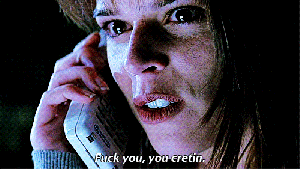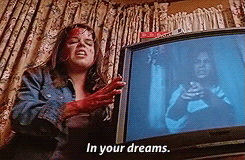
“Do you like scary movies?” Master of horror Wes Craven redefined the boundaries of horror with what many argue is the definitive example of meta horror SCREAM. Although I argue in my Sinister Summer 2019 article that Wes Craven’s New Nightmare was the first to explore the idea of meta horror, there is no doubt that SCREAM is the more popular and truly more meta film. One that not only comments on itself, but on the slasher genre specifically. With the recently greenlit SCR5AM sequel, I thought it would be fun to start out my Sinister Summer 2020 series with the OG! Scream is among my favorite horror properties because you can tell that Wes Craven simply loves the genre and finding new paths to original stories. There are plenty of reasons to love SCREAM. If, for no other reason, it boasts the most brilliant and shocking opening in–not only horror movies–but movies in general. Craven took what Hitch pioneered in Psycho, and amped up the speed at which a popular actress is killed. Whereas Marion Crane was killed off within the first act. Craven kills off American darling Drew Barrymore in the prologue of the film! Still to this day, the opening scene in SCREAM is still the most terrifying opening ever. By killing off Drew Barrymore at the beginning, this communicated to the audience that all bets are off. With the general public, let alone horror fans, becoming all too knowledgable of the rules of horror films thus possessing the ability to predict the outcome and plot turning points, Kevin Williamson and Wes Craven crafted a horror film that changes the rules by using them as a plot device to completely deconstruct the American horror slasher film genre.

But more than a satirical horror film, this film is equally scary. Whereas Scary Movie (the original title to Scream) would do similar things but through parody, slapstick and dark comedy, SCREAM maintains a serious tone throughout the film and never falls into parody. This serious approach is one of the reasons why this innovative film performed incredibly well then and still holds up today. Highly entertaining! This film holds your attention from beginning to end through an incredibly well-developed plot, complex characters, and conflict driven by the actions of the characters. This plot is simple–brilliant–but simple. By relying upon the characters to carry the story, the movie contains more subtext and substance than many others. When you have a character-driven plot, you need solid actors to bring it to life. And all the performances by the principal characters are absolutely perfect for the film. Everyone is so committed to their respective characters. Like bookends, the ending and beginning answer one another.Just as shockingly intense the opening scene is, the climax of the film is surprisingly noteworthy as well, and threw audiences for a loop as it abandons more conventional endings.

As you may know, Drew Barrymore was offered the role of Sidney Prescott. And this was in the mid 90s at the height of Barrymore’s star power. By her taking on the role of the lead character, her name would draw in even more people than would already be excited to see another Craven horror film. After reading the script, Barrymore suggested that she play the role of the opening death. She predicted many people would believe she would survive until the end, and audiences would be shocked by her character’s early demise. And you now what, she was right AND made horror history! Placing Barrymore prominently on the front of the poster, the studio featured her heavily in the various promotional campaigns, leading audiences to believe that Barrymore was the lead in the film. This marketing technique, taken right from the Psycho handbook, reinforced the twists and turns that SCREAM would deliver throughout the film. After that opening scene, audiences knew that all bets were off and that no one–not even American darling Drew Barrymore was safe.
Not only was SCREAM a pivotal horror film that redefined the versatility of the genre, but Sidney stepped into the shoes of all the legendary final girls before her, and took the role in a new direction that cemented her in with the likes of Laurie Strode, Nancy Thompson, and others. Unlike other Craven final girls, she stands as the only one to survive a Wes Craven franchise. Yes, Nancy is brought back in New Nightmare but she is killed off in Dream Warriors. While the final girl conventions had been well-defined up to this point, Wes Craven used the character of Sidney as a conduit for the audience since the rules of slasher horror were all too cliche at this stage in the evolution of the American horror film.
Much like with past final girls, Sidney is resilient, resourceful, sensible, and has an uncanny survivor’s reflex that is so incredibly well developed that she can simultaneously manage life’s complications and death with demonstrable hyper-focus. Furthermore, Neve Campbell’s Sidney was a powerful character for women because she demonstrated strength amidst adversity and responsibility when faced with difficult decisions. However, Sidney is not always the “good girl.” One of the longtime tropes of a final girl is one whom is chaste, but Sidney has had sex with her boyfriend prior to her mother’s brutal murder; however, she chooses when and only when she is good and ready, and when she isn’t dealing with the demons of her past or the serial killer of the present. Much like in the vein of Nancy Thompson, Sidney’s ability to outwit and survive Ghostface is based upon her cunning, not how “good” she is. She is ready and willing it fight for her life, and will stop at nothing until she rescues herself.
Prior to SCREAM, slashers rarely targeted a single victim. For example, Laurie Strode happened to be in the wrong place at the wrong time in Halloween, the same can be said for Alice in Friday the 13th. Less so with Nancy in A Nightmare on Elm Street where Freddy eventually targets Nancy because she discovers his vulnerability. Even different from how Nancy was eventually targeted, Sidney was the sole focus of Ghostface from the very beginning. This target on Sidney means that killing her is the singular focus of Ghostface; and like Sidney’s internal need to survive, Ghostface will stop at nothing until Sidney is dead. But because Ghostface (Billy and Stu) has a flare for the theatrical, he torments, manipulates, and singles her out until Sidney finally fights back in that climactic third act where she turns the tables on Ghostface by using his own tools and knowledge against him. From using his own voice modulator on strategically creepy phone calls to using his own costume to frighten him, Sidney makes intentional decisions that greatly effect the balance of power. While Ghostface holds significant power in the beginning, Sidney erodes that power and takes it for herself. She proves that she has an even greater understanding of horror movies than Ghostface himself, or perhaps the versatility of the rules. Eventually audiences witness Last House on the Left levels of revenge. Interesting because Last House on the Left is Wes Craven’s breakout writing-directing project and redefined the genre with its sexploitation revenge plot.
While a lot of the attention paid to Sidney involves her relationship and confrontation with Ghostface, she is the conduit through which we explore the power dynamic in romantic relationships as well. And the fact that her boyfriend is also her tormenter, offers bountiful material to explore. In many ways, the relationship between Billy/Sidney and Ghostface/Sidney parallels one another. Ghostface wants to penetrate Sidney with his knife, but she refuses to give up on resisting; likewise, Billy desires to penetrate Sidney with his own weapon but she withholds until she has worked through her personal demons. Billy attempts to make Sidney feel guilty for not engaging in her “girlfriendly” duties, as a misogynist such as Billy would put it; likewise, Ghostface tries his best to make Sidney feel guilty for the death of her mother. These parallels are why Sidney defeating Billy/Ghostface is so important and meaningful. Not only does she kill the demons that are presently haunting her, this defeat also allows Sidney to finally close the book on the demons of her past trauma.

There is more to a great slasher that the final girl and villain; those elements alone do not a classic make. Although there were many fantastic horror films in the 1990s, I argue that SCREAM is THE decade defining horror film. Other significant contributions to 90s slasher horror are I Know What You Did Last Summer, Halloween H20, and The Faculty. Because of how well it holds up, it’s hard to believe that it’s been nearly twenty-five years since SCREAM began terrifying audiences around the globe. With witty dialogue, twisted plot lines, and pop culture references, SCREAM has earned its tenure amongst other classic horror motion pictures. The strength of SCREAM is in the screenplay by Kevin Williamson brought to life by the brilliant Craven direction. In any film, the screenplay is responsible for the very framework of the film. More than a map between the beginning and end, the screenplay dramatizes conflict and manifests ideas in either a linear or nonlinear storytelling structure. Think about it: a screenwriter is the very first person to see a movie–even before the director. He or she knows this cinematic story inside and out. And it’s the challenge of the screenwriter to take the cinematic vision from his or her mind, and translate it for the screen in an effective method for crafting an emotional and psychological connection between the audience and characters.

Screenplays are responsible for crafting a compelling narrative out of otherwise disconnected ideas, simple plots, or premises. This is where the very foundation of a motion picture lies. Without a well-crafted screenplay written by a writer who cares, the characters lack motivation, there is little cause & effect or meaning to the plot devices. The words of a thoughtful screenplay form visual statements that allow for the motion picture to be supported by subtext or purpose. One of the most important elements in a screenplay that so often gets overlooked is the task of creating a cast of extremely likable and realistic characters that the audience instantly becomes invested in. Kevin Williamson’s SCREAM screenplay offers audiences an exciting film with ample twists & turns, with an almost whodunit quality about it. As mentioned earlier in the article, SCREAM is one of the first horror films to approach horror from a meta perspective. The film takes a self-referential look at horror cinema by poking fun at the clichés for which the genre is well-known while simultaneously playing into almost every single one of them. But the film never patronizes its audience nor acts as if the audience is not in on the joke.
Often imitated, but never replicated, SCREAM is a pivotal horror film that pushed the boundaries of the horror genre and cinema at large. It represents the third time that Wes Craven was instrumental in redefining the genre: the first time was Last House on the Left then A Nightmare on Elm Street and lastly SCREAM. More than any other director, Craven has been the most pioneering in the genre. While he may have more box office flops than successes on his filmography, his films consistently sought to be trailblazers. In terms of studio history, he quite literally saved New Line Cinema from closing when he wrote and directed A Nightmare on Elm Street. And one could even say that Craven saved the slasher genre from extinction with SCREAM.

Ryan teaches screenwriting and American cinema at the University of Tampa. If you like this article, check out the others and FOLLOW this blog! Interested in Ryan making a guest appearance on your podcast or contributing to your website? Send him a DM on Twitter or email him at RLTerry1@gmail.com! If you’re ever in the Tampa area, feel free to catch a movie with him!
Follow him!
Twitter: RLTerry1





Pingback: Sinister Summer 2020 “I know What You Did Last Summer” Retrospective | The R.L. Terry ReelView
Pingback: Sinister Summer: Dream Warriors | The R.L. Terry ReelView
Pingback: SCREAM (2022) horror movie review | R.L. Terry ReelView
Pingback: SCREAM VI horror movie review | R.L. Terry ReelView
Pingback: THANKSGIVING (2023) horror movie review | R.L. Terry ReelView